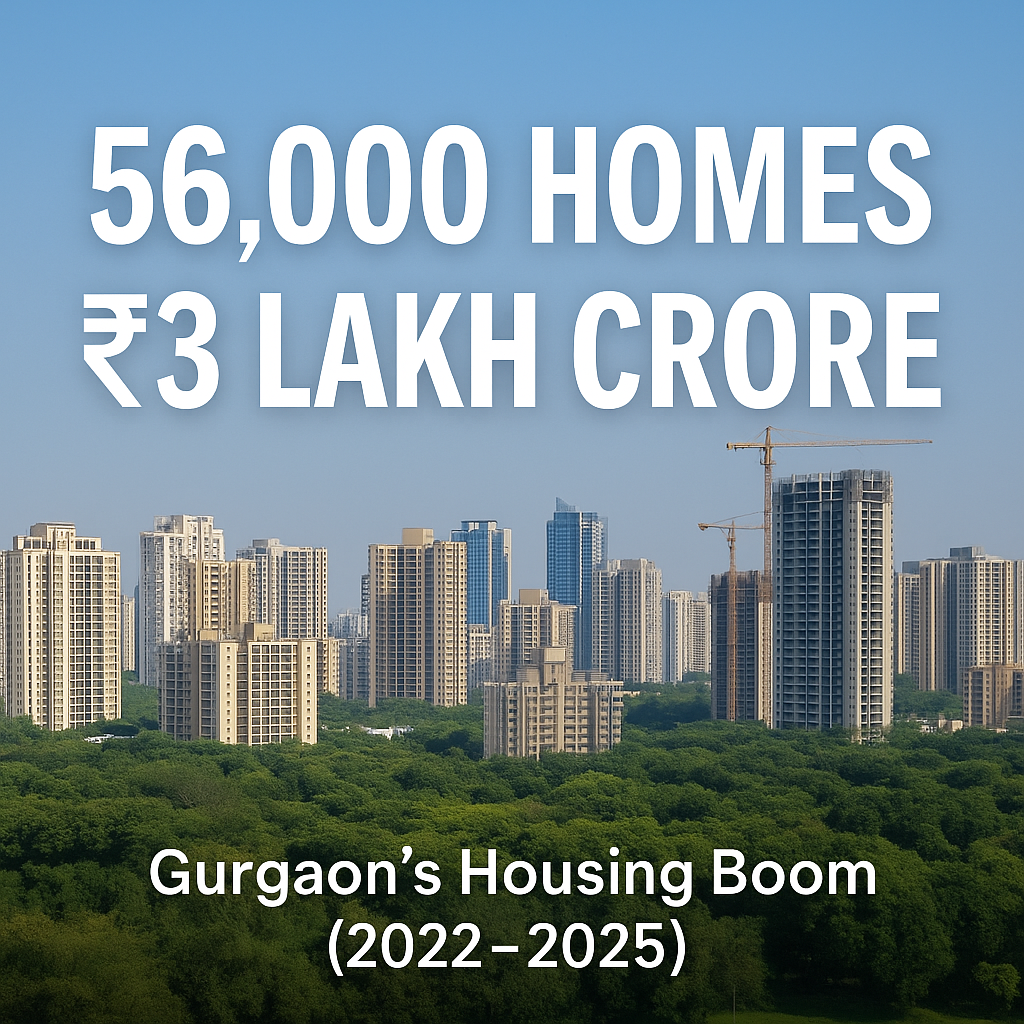Between 2022 and 2025, Gurgaon has witnessed a housing boom unlike anything seen before. In just three years, developers have launched more than 56,000 residential units — from budget-friendly floors to ultra-luxury condominiums with ticket sizes upwards of ₹20 crore.
On paper, the math looks staggering:
56,000 units launched
₹10,000–22,000 per sq ft price range
₹2.5–3 lakh crore in potential sales value
That’s larger than the GDP of many small countries.
But here’s the paradox: India’s income tax data shows that only a very small fraction of people declare incomes above ₹25 lakh per year. So how are thousands of ₹5–10 crore homes being “sold out overnight” in Gurgaon? Who are these buyers — and can this boom really sustain?
Builder-Wise Breakdown (2022–2025 HRERA Data)
Here’s a snapshot of launches based on Haryana RERA registrations:
DLF – 5,234 units (Privana, Arbour, Alameda Floors, Garden City, Dahlias, Groove). ₹5–10+ crore.
M3M – 9,721 units (Altitude, Antalys Hills, Capital Crown, Golf Hills, Mansion, Solitude). ₹3–6 crore.
Signature Global – 10,630 units (DXP Vista, Titanium, Twin Towers, Park, City). ₹1.5–5 crore.
Godrej – 3,767 units (Aristocrat, Astra, Icon, Miraya, Zenith, Vrikshya). ₹3–7 crore.
Emaar – 2,424 units (Amaris, Emerald Hills, Oasis, The 88). ₹3–5 crore.
Whiteland – 2,272 units (Aspen, Urban Resorts, Blissville). ₹3–7 crore.
Trump – 560 units (Trump Towers & Residences). ₹5–10 crore.
Tulip – 2,078 units (Monsella, Crimson, Violet). ₹3–8 crore.
Sobha, Elan, Birla Estates, BPTP, Experion, Adani, Silverglades, Navraj, SS Group, SmartWorld, Krisumi, Conscient, Ashiana, JMS, ROF any many on list… — together, thousands more in the ₹3–7 crore bracket.
Total = 56,000+ units launched in 3 years. ( Actal Sales of these units Not Disclosed Anywhere)
The Income Paradox:
India’s tax base does not seem to support such massive luxury absorption:
Less than 5 lakh individuals nationwide report taxable incomes above ₹1 crore.
Even fewer declare between ₹25–50 lakh annually.
Yet one single project like DLF Arbour sold ₹7,000 crore worth of homes in 3 days.
This raises a fundamental question: if not pure end-users, then who exactly is driving this demand?
Who is Buying These Homes?
From market insights and buyer patterns, the likely breakdown looks like this:
NRIs (20%) – Reinvesting in India, leveraging currency arbitrage, betting on steady rental yields.
HNIs & CXOs (20%) – Upgrading lifestyles, buying second homes, diversifying wealth.
Business families (10%) – Moving beyond traditional investments into real estate.
Speculators (50%) – Using the 30:40:30 construction-linked plan.
For speculators, the strategy is simple:
Pay 30% upfront (~₹1.5 crore on a ₹5 crore flat).
Hold for 1–2 years while prices rise.
Flip before the next 40% payment is due.
This explains the “sold out overnight” headlines — but it also injects risk into the system.
The Bigger Question: Cash in Hand vs. Paper Sales
Here’s what most headlines don’t tell you:
These 56,000 homes are valued at ₹3 lakh crore, but developers have actually collected only about 30% upfront = ~₹90,000 crore.
The remaining ₹2+ lakh crore is yet to come. It depends entirely on:
buyers honoring future payments,
banks continuing to fund loans,
projects being delivered on time.
If demand slows, or if speculators can’t pay the next 40% and 30%, will these numbers still hold? Or will some of this “boom” stall midway?
Why This Matters
This housing surge isn’t just about real estate — it reflects deeper forces:
India’s growing wealth concentration.
Gurgaon’s rise as the NRI + corporate capital of North India.
The psychology of real estate as a tangible, aspirational asset compared to volatile stocks or gold.
The role of speculation in inflating demand far beyond actual end-user absorption.
Conclusion
Gurgaon today is not just selling homes. It’s conducting India’s largest luxury housing experiment.
The question is not only: “Who bought these 56,000 homes?”
It’s also: “Will the full ₹3 lakh crore ever flow, or will the boom stop at 30%?”
– Note: These numbers are based on HRERA registrations, developer announcements, and leading property reports. Figures may vary across sources, but the larger picture is clear — Gurgaon has seen 56,000+ homes launched between 2022–2025.

